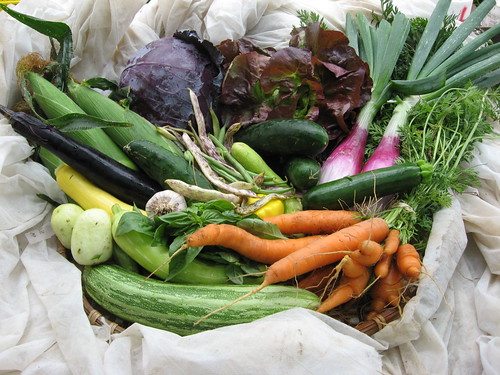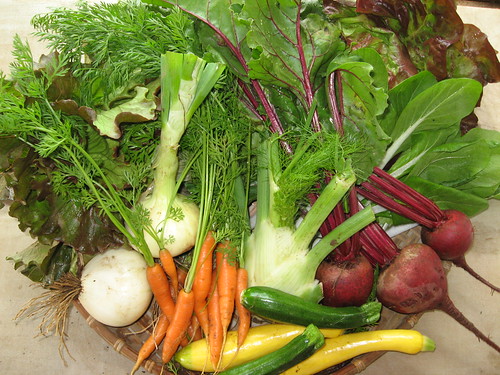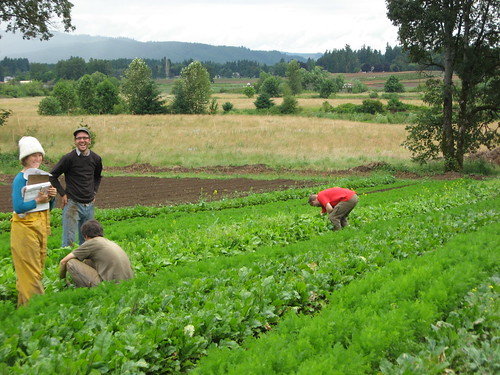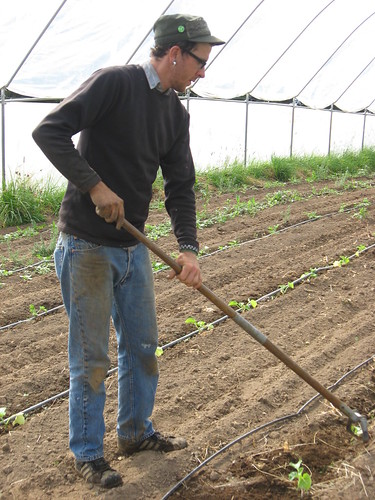This Week’s Share
- Carrots
- Celery
- Cucumbers
- Eggplant
- Garlic
- Kale
- Lettuce
- Potatoes
- Summer Squash
- Tomatoes
Carrots – Fresh, sliced, diced, shredded, steamed, roasted or stewed carrots are a fantastic sweet vegetable for all seasons. I like mine roasted with maple syrup and either raisins or rosemary.
Celery – A hearty welcome to celery. The variety of celery we grow is called ‘Tall Utah’, and it surely is tall, it’s also quite fragrant too. Treat this celery as an herb, a delightful addition to soups, stews and other kitchen endeavors, instead of the kind of celery you would use for ants on a log (aka snacking). This celery might taste a bit too strong if you just eat is raw. I recommend flavoring your tomato juice with a stick of this celery.
Cucumber – The cucumbers are starting to slow down a bit, so your share of these delicious summer treats will start to get smaller. Use your cucumbers this week to make a delicious pickled cucumber salad.
Eggplant – Eggplant, the spongiest vegetable in your share, is a wonderful summer treat. My favorite method for cooking eggplant is rubbing slices or halves with canola oil, sesame oil and miso paste and then broiling in the oven until brown. Makes a great pizza, salad or pasta topping.
Garlic – Use garlic in your pesto or in almost any dish. Try your garlic roasted…peel cloves, coat with olive oil and roast in the oven until the color changes and the texture turns soft.
Kale – Welcome ‘Winterbor’ Kale. The second planting of kale has finally come on strong and we are excited to include a bunch of this curly kale in your share. Kale is a multi-function vegetable. You can steam or sauté it briefly to enjoy this vegetable still crisp. You can also cook it down further and cook it in balsamic vinegar for a delicious side dish. Kale, chopped finely, is also a wonderful addition to quiches, soups and grain dishes.
Lettuce – A simple summer salad is the best dinner on a warm night. Wash and tear off your lettuce leaves. Add shredded carrots, sliced cucumbers and diced tomatoes and top with a roasted garlic vinaigrette.
Potatoes – This week you will be getting Yukon Gold or Yellow Finn potatoes in your share. Nothing beats a freshly harvested potato. I love potatoes roasted in a vegetable medley, especially on the grill. See the recipe below. These delicious potatoes are also wonderful cubed and cooked in your favorite soup.
Summer Squash – The varieties of summer squash are also starting to slow down too. Enjoy them while they are still with us.
Tomato – The tomatoes keep coming on stronger and stronger. How fantastic to finally have them with us. I recommend making homemade tomato juice and dressing it up with a little celery.
*Basil – This week Wednesday Box and Friday Box will receive a bulk basil distribution in their shares. This is the time to make some tasty pesto to keep in the freezer until winter.
Recipes
Apple and Celery Bread
from cooks.com
2 c. apples, fresh, diced (do not peel)
1/2 c. celery, fresh, diced
3 lg. eggs
1 c. vegetable oil
1 3/4 c. sugar
3 c. flour
1 tsp. salt
1 tsp. baking soda
1 tsp. cinnamon
1/2 tsp. baking powder
Beat eggs in mixing bowl. Add oil and sugar; mix well. Add apples and celery; blend. Sift together dry ingredients and add to above mixture; just to blend. Pour into a greased loaf pan and bake at 350 degrees for 1 hour.
Roasted Eggplant Dip
adapted from How to Cook Everything
The author says “roasting eggplant gives it such a wonderful smoky flavor that even people who claim to not like eggplant often eat this dip enthusiastically”.
2 medium or 4 small eggplant
¼ c freshly squeezed lemon juice
¼ c extra-virgin olive oil
½ t minced garlic, or to taste
½ c freshly grated parmesan cheese
salt and fresh ground black pepper to taste
minced fresh parsley for garnish (optional)
Start a charcoal or wood fire, preheat a gas grill, or turn the oven on to 500 degrees. Pierce eggplant in several places. Grill or roast, turning occasionally, until the eggplant collapses and the skin blackens, about 15-30 minutes. Remove and cool. When cool enough to handle, open the skin and scoop out the eggplant flesh. Mince finely and mix with lemon juice, oil, garlic, cheese, salt and pepper. Taste and adjust seasonings as necessary, garnish, serve with bread or crackers.
Potato Latkes
adapted from The New Laurel’s Kitchen
“These richly flavored yeast-raised potato pancakes are light, delicious, and not at all greasy – wonderful not only for breakfast, but at any time of day.”
2 medium potato
1 egg, beaten
1 t salt
½ c whole wheat flour
¼ c wheat germ
2 t active dry yeast
1 c warm mil, stock or water
1 T onion (or more)
1 T oil
Sauté onion in oil. Dissolve yeast in liquid. Grate potato and mix together with egg, salt, flour, and wheat germ. Add the onion with its oil. Let rise 30 minutes. Stir down. Cook over medium heat on lightly oiled griddle until browned on each side, about 6-7 minutes. Serve with applesauce and yogurt. Makes 8 pancakes.
Grilled Veggie Medley
Start up the grill (or the hot coals at your camp site). Cube and slice potatoes, eggplant, summer squash, carrots, celery, garlic, onion, peppers and even tomatoes. Coat with olive oil and sprinkle with salt, pepper and your favorite herbs. Then wrap into a tin foil pod and throw on the barbeque or put it in the coals. Flip once or twice and then open for moist, delicious vegetables.
What’s Going on at the Farm?
This is a wonderful time of year at the farm. The skies are still clear and bright, the angles of our shadows are changing dramatically, and the hue of the sunlight is a warmer and a deeper yellow. The crops are all roaring along at the peak of their production. The peppers keep marching along their path, just waiting to change from green to the magical rainbow of colors to which they will mature. The irrigation schedule is slowing down as we harvest more crops but seed fewer replacements and fill in empty spots with the last of the summer cover crop. The hearty winter crops are growing with speed and soon winter squash, cabbage, and spinach will be knocking on our door again. It’s hard to believe the time is moving this quickly!
An Excellent Opportunity to Reduce, Re-Use and Recycle
Here are some tips for using the three Rs (Reduce, Re-Use and Recycle) at your veggie pick up site.
1. Bring your own bag or bags for vegetable transport. Canvas and cloth are good options because they can get washed or rinsed as needed. Just throw all your veggies in there and a little water or soil won’t hurt, which eliminates the need for all produce to go home in individual plastic bags. Circulate two bags in rotation, one with your bike/car and one in the house so you’ll always have one with you. You can also re-use paper or plastic grocery bags from the store or previous week of drop. Every re-used bag is one less ‘virgin’ bag (and newly harvested raw materials) that gets put into the waste stream.
2. Collect your paper bags (from the store or from drop) and bring them to share at drop for yourself and other members to use. That way, when you forget to bring your bag…there will already be a used bag waiting for you.
3. About the thin plastic film bags…although these bags come in handy for bagging a wet head of lettuce or some tomatoes that might get squished and leak on the way home, they aren’t necessary for bagging every item. Consider conserving bags by combining only wet produce (lettuce, kale, etc) or delicate produce you are concerned about into one bag. This saves bags and time. These bags are also easily saved and re-used from week to week by rinsing quickly and hanging to dry upside down on a dish rack. Luckily, your produce gets along real well with each other and is more than happy to sit lumped together in your bag until you get home to unpack it.
4. And for the recycling part…you can recycle paper bags that have passed their prime, or you can re-use them as wrapping paper or bedding for your worm composting bin. You can even save up your spent plastic film bags and recycle them at the Master Recycler Plastic Round-ups that occur three times per year (see information and link below).
FREE Master Recycler Plastic Roundups
Saturday, September 29, 2007, 9am to 2pm
Floyd Light Middle School 10800 SE Washington
Kaiser Permanente 3325 N Interstate (off Fremont & Overlook Park)Saturday, October 6, 2007, 9am to 2pm
PCC Sylvania 12000 SW 49th Lot 10
Westview High School 4200 NW 185th North Parking Lot
Apprentice Beds
Every year the second-year apprentices get one 180′ bed at the farm on which we can experiment with crops or techniques that we don’t otherwise use at the farm. Planning and managing my apprentice bed has been a fun challenge, with an emphasis on the challenge part. Much like the rest of the farm, I did my planning during the winter months of January and February. Between my over zealous visits with the Seed Savers Exchange catalog and the large number of seeds I acquired at seed swaps, it was hard to narrow down my options and pick a sane amount of crops to plant. I had a few definite crops I wanted to include: heirloom melons, storage onions, small-long storing winter squash, cherry tomatoes, sunflowers, Zulu Prince daisy, a few varieties of hot peppers, and tomatillos. But then I found varieties I just had to have, like black tomatoes and beans and edamame and the list goes on and on. The planning and seeding in the greenhouse was easy compared to the planting out, weeding and harvesting. I forgot how long our work days are in the hot sun and how hard it is to do anything after a long day on the farm, nonetheless more farming. However, I’ve done my best to visit my apprentice bed a couple times a week, weed it when I can, and watch the progress of all my crops with delight and much impatience! The absence of a long, hot summer has kept my melons from ripening yet, and I can hardly wait for them to be ready (and I have cut open enough un-ripe melons to have learned my lesson). It has been wonderful to experience a 180′ mini-farm from start to finish, and I have learned a lot of lessons in the process. Here are a few lessons learned. 1) Always trellis tomatoes. They sure need it to stay healthy and it makes harvest much easier. 2) When the seed packet says 18″ spacing, they sure do mean it. 3) Label everything and 4) Patience is key!
 The Next Step
The Next Step
I am excited to say that I have accepted a placement as an AmeriCorps Volunteer with the Northwest Service Academy (starting mid-September) to serve at the ‘Garden of Wonders’ Food and Garden education program at Abernethy Elementary School. I am looking forward to a year of integrating my newly acquired farming knowledge into a school garden setting and getting to teach again, yay!





 Plate and Pitchfork
Plate and Pitchfork
 I’ll write my field notes this time, from the pages of my three ring binder that I lug around with me constantly these days – referring to spreadsheets and recording harvest notes. This notebook holds the map of the season that we chart in the cold winter months, snuggled up to the computer, dreaming and scheming about the season ahead. We imagine the perfect CSA share and then work backwards from there, determining the seeding and planting dates to achieve this harvest. All of this planning is bound together in the multiple excel spreadsheets that fill my farm binder. In the dizziness of summer that is upon us, with pounds and pounds of vegetables flowing into the barn, I take refugee in these notebook pages. They offer me a chance to get my bearings – to figure out where we are between the vision we had back in January and the reality of what the season brings.
I’ll write my field notes this time, from the pages of my three ring binder that I lug around with me constantly these days – referring to spreadsheets and recording harvest notes. This notebook holds the map of the season that we chart in the cold winter months, snuggled up to the computer, dreaming and scheming about the season ahead. We imagine the perfect CSA share and then work backwards from there, determining the seeding and planting dates to achieve this harvest. All of this planning is bound together in the multiple excel spreadsheets that fill my farm binder. In the dizziness of summer that is upon us, with pounds and pounds of vegetables flowing into the barn, I take refugee in these notebook pages. They offer me a chance to get my bearings – to figure out where we are between the vision we had back in January and the reality of what the season brings.
 Last Monday we hosted a Farmscaping for Beneficials walk on our farm. These walks are sponsored by OSU and The Xerces Society who are working together on a project to support grower-led activities that build the knowledge and implementation of conservation biological control (CBC) on local farms. Conservation biological control can be defined as methods used on and around farms to restore and enhance beneficial organism populations that can increase to numbers that may limit pest populations. Such methods may include insectary plantings, grassy field margins, beetle banks and hedgerows. We have implemented several of their strategies on our farm to encourage beneficials: whenever possible we allow our cover crop to flower; we grow many cut flowers on the farm, and we have edges that are not disturbed by tillage. We continue to learn what we can do to create habitat that will encourage beneficials and help us to be better farmers.
Last Monday we hosted a Farmscaping for Beneficials walk on our farm. These walks are sponsored by OSU and The Xerces Society who are working together on a project to support grower-led activities that build the knowledge and implementation of conservation biological control (CBC) on local farms. Conservation biological control can be defined as methods used on and around farms to restore and enhance beneficial organism populations that can increase to numbers that may limit pest populations. Such methods may include insectary plantings, grassy field margins, beetle banks and hedgerows. We have implemented several of their strategies on our farm to encourage beneficials: whenever possible we allow our cover crop to flower; we grow many cut flowers on the farm, and we have edges that are not disturbed by tillage. We continue to learn what we can do to create habitat that will encourage beneficials and help us to be better farmers. This is the second year that Sauvie Island Organics is involved with the Janus Youth Food Works’ program. Food Works is a youth employment program, which engages 14-21 year olds in all aspects of planning and running an entrepreneurial farm business. Their farm is adjacent to ours on Sauvie Island. On Fridays, the one day that we do not harvest and use our barn for pack out, we hear the music of the Food Works youth as they bring their harvest in for washing and packing. You can find them each Saturday at the PSU farmers’ market downtown.
This is the second year that Sauvie Island Organics is involved with the Janus Youth Food Works’ program. Food Works is a youth employment program, which engages 14-21 year olds in all aspects of planning and running an entrepreneurial farm business. Their farm is adjacent to ours on Sauvie Island. On Fridays, the one day that we do not harvest and use our barn for pack out, we hear the music of the Food Works youth as they bring their harvest in for washing and packing. You can find them each Saturday at the PSU farmers’ market downtown.
 My name is Kylie and I have been working here at Sauvie Island Organics for a little over a month now. I traveled from a land where yellow brick roads and ruby red slippers can be found on t-shirts in souvenir shops. From Kansas I journeyed west to check out the agricultural scene. I stumbled upon the organic farming scene about a year and a half ago with one semester left before my graduation from the University of Kansas. I was in need of one more credit in order to graduate and decided to take a look at the connection that people have with their food’s roots. I did an apprenticeship on a small farm in Oskaloosa, Kansas and got a taste of, what you all are taking part in, the CSA. I’m in love with this personal form of farming and am excited to meet more of you as the season progresses.
My name is Kylie and I have been working here at Sauvie Island Organics for a little over a month now. I traveled from a land where yellow brick roads and ruby red slippers can be found on t-shirts in souvenir shops. From Kansas I journeyed west to check out the agricultural scene. I stumbled upon the organic farming scene about a year and a half ago with one semester left before my graduation from the University of Kansas. I was in need of one more credit in order to graduate and decided to take a look at the connection that people have with their food’s roots. I did an apprenticeship on a small farm in Oskaloosa, Kansas and got a taste of, what you all are taking part in, the CSA. I’m in love with this personal form of farming and am excited to meet more of you as the season progresses.
 Our old farm truck has been retired from the road. It is now confined to the fields where it seems most at home. We have recently acquired a little red pick-up from a CSA member that will allow us to run our errands off farm. Thank you Laleña!
Our old farm truck has been retired from the road. It is now confined to the fields where it seems most at home. We have recently acquired a little red pick-up from a CSA member that will allow us to run our errands off farm. Thank you Laleña! Saturday evening we had a wedding on the farm. Congratulations Amber and Jason! Amber and Jason met as apprentices in 2005 here at Sauvie Island Organics.
Saturday evening we had a wedding on the farm. Congratulations Amber and Jason! Amber and Jason met as apprentices in 2005 here at Sauvie Island Organics.











 The new set up has also changed the way we seed most of our cover crops. The drop spreader will drop small seed as well as soil amendments so Scott has been seeding with the spreader. He can drag a ring roller behind the tractor which presses the seeds into the soil and this does save a step in seeding cover crop, as well as making it more convenient to do. As a result we have beautiful summer stands of sudan and buckwheat out in the fields right now (The photo below is the most beautiful field of sudan we’ve ever had with vegetables in the background).
The new set up has also changed the way we seed most of our cover crops. The drop spreader will drop small seed as well as soil amendments so Scott has been seeding with the spreader. He can drag a ring roller behind the tractor which presses the seeds into the soil and this does save a step in seeding cover crop, as well as making it more convenient to do. As a result we have beautiful summer stands of sudan and buckwheat out in the fields right now (The photo below is the most beautiful field of sudan we’ve ever had with vegetables in the background).



 Hello, my name is Brian and I’m a first-year apprentice. Living and working out at the farm is a wonderful way to learn about sustainable farming practices. I’ve really enjoyed watching the season progress thus far and am excited about watching the farm change through the rest of the year. This is going to be my second year working on an organic farm. Last year I worked as an apprentice with Beth Gibans in Joseph, OR. Some of you may remember her from her days working here with Shari at Sauvie Island Organics. I’m really looking forward to the rest of the season and all of the wonderful opportunities that SIO has in store for me. See you Soon. Brian
Hello, my name is Brian and I’m a first-year apprentice. Living and working out at the farm is a wonderful way to learn about sustainable farming practices. I’ve really enjoyed watching the season progress thus far and am excited about watching the farm change through the rest of the year. This is going to be my second year working on an organic farm. Last year I worked as an apprentice with Beth Gibans in Joseph, OR. Some of you may remember her from her days working here with Shari at Sauvie Island Organics. I’m really looking forward to the rest of the season and all of the wonderful opportunities that SIO has in store for me. See you Soon. Brian Flowers are on their way. Next week we’re expecting to harvest the first cuts of the season. There are still a few flower shares left so if you’d like to sign up there’s still time. Stay tuned next week for more information on how to care for cut flowers.
Flowers are on their way. Next week we’re expecting to harvest the first cuts of the season. There are still a few flower shares left so if you’d like to sign up there’s still time. Stay tuned next week for more information on how to care for cut flowers.
 Potatoes – Potatoes are traditionally cured after harvest to thicken the skin. This week you are receiving new potatoes. These freshly harvested, uncured potatoes have a thin delicate skin and are particularly flavorful. This week we have three varieties: the red is called Sangre, the blue is All Blue, and the white is Yukon Gold. Note the festive color scheme for the upcoming holiday, and enjoy them in the recipe below.
Potatoes – Potatoes are traditionally cured after harvest to thicken the skin. This week you are receiving new potatoes. These freshly harvested, uncured potatoes have a thin delicate skin and are particularly flavorful. This week we have three varieties: the red is called Sangre, the blue is All Blue, and the white is Yukon Gold. Note the festive color scheme for the upcoming holiday, and enjoy them in the recipe below.

